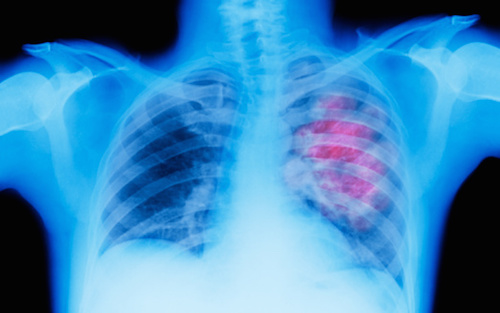
Researchers from the Moffitt Cancer Center report they are developing a noninvasive, method to analyze a patient’s tumor mutations and biomarkers to determine the best course of treatment.
Their findings, “Noninvasive decision support for NSCLC treatment using PET/CT radiomics,” is published in Nature Communications. The researchers demonstrate how a deep learning model using positron emission tomography/computerized tomography (PET/CT) radiomics may identify which non-small cell lung cancer patients may be sensitive to tyrosine kinase inhibitor treatment and those who would benefit from immune checkpoint inhibitor therapy.
NSCLC is a disease in which malignant cells form in the tissues of the lung. There are different types of treatment for patients with non-small cell lung cancer including surgery, radiation therapy, chemotherapy, targeted therapy, and more.
“Two major treatment strategies employed in NSCLC are tyrosine kinase inhibitors (TKIs) and immune checkpoint inhibitors (ICIs). The choice of strategy is based on heterogeneous biomarkers that can dynamically change during therapy. Thus, there is a compelling need to identify comprehensive biomarkers that can be used longitudinally to help guide therapy choice. Herein, we report an 18F-FDG-PET/CT-based deep learning model, which demonstrates high accuracy in EGFR mutation status prediction across patient cohorts from different institutions,” the researchers wrote.
The EGFR—which stands for epidermal growth factor receptor—contributes to the growth of some lung cancers and drugs that block the activity of EGFR slow cancer growth and prolong survival. EGFRs are small proteins that are found on the surface of all cells and proteins circulating in the blood called growth factors. The binding action between EGFR and growth factors stimulates biological processes within the cell to promote growth of a cell in a strictly controlled manner. However, in many cancer cells, EGFR is either abundantly overexpressed or the EGFR biological processes that normally stimulate cell growth are constantly active. This leads to the uncontrolled and excessive growth of the cancer cell.
“…EGFR is a common mutation found in non-small cell lung cancer patients. EGFR mutation status can be a predictor for treatment, as patients with an active EGFR mutation have better response to tyrosine kinase inhibitor treatment,” explained Matthew Schabath, PhD, associate member of the cancer epidemiology department.
The researchers developed an 18F-FDG PET/CT-based deep learning model using retrospective data from non-small cell lung cancer patients at two institutions: Shanghai Pulmonary Hospital and Fourth Hospital of Hebei Medical University in China. 18F-FDG PET/CT is used in determining the staging of patients with non-small cell lung cancer.
“Prior studies have utilized radiomics as a noninvasive approach to predict EGFR mutation,” said Wei Mu, PhD, study first author and postdoctoral fellow in the cancer physiology department. “However, compared to other studies, our analysis yielded among the highest accuracy to predict EGFR and had many advantages, including training, validating, and testing the deep learning score with multiple cohorts from four institutions, which increased its generalizability.”
“We found that the EGFR deep learning score was positively associated with longer progression-free survival in patients treated with tyrosine kinase inhibitors, and negatively associated with durable clinical benefit and longer progression-free survival in patients being treated with immune checkpoint inhibitor immunotherapy,” said Robert Gillies, PhD, chair of the cancer physiology department. “We would like to perform further studies but believe this model could serve as a clinical decision support tool for different treatments.”
This model will help overcome the heterogeneous biomarkers that can change during therapy and will help identify the best course of treatment for those with NSCLS. It may also one day contribute to a higher survival rate compared to the five-year survival rate of 5% for the patients diagnosed with metastatic disease.













